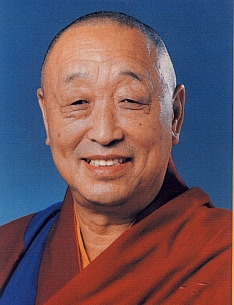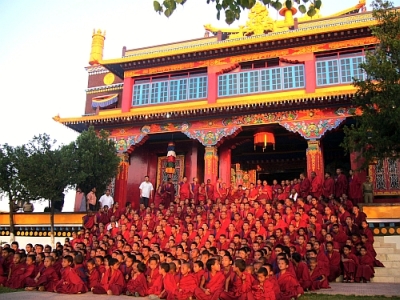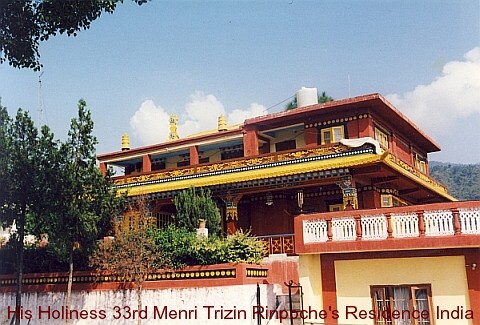
His Holiness 33rd Abbot of Menri, Spiritual Leader of Bön
His Holiness Lungtok Tenpa’i Nyima was the worldwide spiritual leader of the Bon religion of Tibet until his passing in September 2017. His Holiness was born in Amdo, in the far eastern region of Tibet, in 1927 and became a monk at the age of eight, at Kyong Tsang Monastery. When he was sixteen he entered the Dialectic School at the monastery, and after eight years of study received his Geshe degree, specializing in Tibetan medicine, astronomy, and astrology. Soon after, at the age of twenty-six, he traveled to Gyalron in Eastern Tibet, where he printed the Bönpo scriptures, the Kangyur, from wood blocks kept by the king of Trochen Gyalpo, one of the eighteen kingdoms of Gyalrong. This is a set of over one hundred books. He then brought the published Kangyur back to Kyong Tsang Monastery. Then he traveled to Central Tibet in Tsang province, for further studies at the Bön monasteries of Yung Drung Ling, Menri and Khana. Later he went to Drepung monastery in Lhasa to do research and practice, staying five years until the 1959 uprising.
At the time of the conflict against the Chinese in 1959 he fled on foot from Tibet to Mustang, on the border of Tibet and Nepal, then to Pokhara, Nepal, and then to India. Later he joined the Abbot of Yung Drung Ling monastery and many Bönpo lamas in the Bön monastery of Samling, a very old and important monastery in the Dolpo region of Nepal. Later he went back to Samling monastery in order to borrow books so that they might be republished. The books of the Bönpo are very important for practice and study, but many of them were left behind or lost when the lamas had fled Tibet. Often, the only remaining copies were in remote areas and needed to be republished. While at Samling, H.H. Lungtok Tenpa’i Nyima met Dr. David Snellgrove, a researcher of Oriental and African studies from London University. Dr. Snellgrove later invited him, Samten Gyaltson Karmay, and Lopon Tenzin Namdak to come to England with him under the sponsorship of the Rockefeller Foundation. There they taught Tibetan culture and religion and studied the ways of the West. Sangye Tenzin Jong Dong, as he was then called, stayed in England for three years. He lived and studied with Benedictine, Cistercian and other Christian monastic orders, and traveled to Rome to meet Pope Paul II. In 1964, he returned to India to found a school funded by sponsors in England. His Holiness the Dalai Lama asked him to start the school in Massori, India, and he staffed it with volunteer teachers from the West. He remained as head of the school for three years, teaching Tibetan grammar and history. Each month he sent his salary, three hundred rupees a month, to the refugee Bönpo lamas living in Manali, India to buy food. He also helped create a meditation center in Manali for the lamas and monks. Later the school was moved to the south of India, where it became the first permanent Tibetan settlement in the region. In 1965, Lopon Tenzin Namdak returned to India and with the help of the Catholic Relief Service purchased land in Himachal Pradesh, India to found Dolanji, the home for the Tibetan Bönpo refugee community.
In 1966, Geshe Sangye Tenzin Jong Dong traveled to the University of Oslo, Norway at the invitation of Per Kvaerne, where he taught Tibetan history and religion for two years. On March 15, 1968 he received a telegram from India which stated that the Protectors of Bön had selected him as the 33rd Abbot of Menri, and spiritual leader of the Bönpos. The Abbot of Yung Drung Ling, Lopon Sangye Tenzin, Lopon Tenzin Namdak, and about ten other Bönpo Geshes had prayed in the Drup Khang, or Protector’s temple, for fourteen days. The guardians then selected Geshe Sangye Tenzin Jong Dong from a group of ten Geshe monks eligible to be the new Abbot through a divination process.
Longevity Prayer of H.H. 33rd Menri Trizin Rinpoche
E MA HO
RAB JAM CHHOK CHU GYAL WA SE CHE KYIThe omniscient wisdom of the Buddhas and Bodhisattvas of the ten directions
KHYEN TSE YESHE NGO WO CHIK DUI PI
Is condensed into a single essence in you, Highest One
ZAB GYE SHEN TEN PEL WE THRIN LE CHEN
Possessor of the enlightened activity of the profound, expanded, increasing teachings of Tonpa Shenrab
LUNG TOG TENPAI NYIMA TAG CHHAR SHOG
We pray that you Lungtok Tenpa’i Nyima shine forever.
Listen to the long-life prayer chant:

So he returned to India and assumed his duties as the spiritual leader of the Bönpo at a very crucial time in their long history. Their world had been destroyed and their lineage almost lost, but he had to lead them to a new beginning. It would take a very strong and compassionate man to help them build new monasteries and schools, and to save their culture and religion in strange and new surroundings. Many lamas came from Tibet, Nepal and India to give him their initiations and teachings, and for over one year he intensively trained and practiced for his role as Abbot, the leader who would guide the Bönpo and hold all the teaching lineages. Slowly over time he was able to build a new Menri monastery in Dolanji, and after that a Bön Dialectic School, which has now awarded thirty seven geshe degrees, with a certification recognized by H. H. the Dalai Lama. He also founded an orphanage at the monastery for Bön children, the Bön Children’s Welfare Center. Today there are approximately four hundred Tibetans living in Dolanji, along with one hundred orphans and one hundred monks. Two hundred and fifty Bönpo children from all over India and Nepal attend the boarding school in the village. Dolanji has become a thriving center of Tibetan culture and religion under the guidance of His Holiness Lungtok Tenpa’i Nyima.


